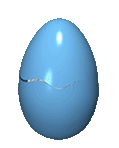 Groups of conservationists are monitoring the rhino and have drilled into the rhino's horn, using an electric drill powered by a generator sitting on the back of a pick-up truck.
Groups of conservationists are monitoring the rhino and have drilled into the rhino's horn, using an electric drill powered by a generator sitting on the back of a pick-up truck.They have burrowed an eight centimeter hole, about an inch wide. Inside they embedded a silver canister and then plugged up the incision with putty and wrapped some masking tape over the rhino horn, like a make-shift bush bandage.
This radical surgery is an experiment that many in South Africa hope will help to restrict the massive surge in rhino poaching. More than 250 rhinos have been slaughtered for their horns this year, a massive increase compared to previous years.
The hope is that the technology inside the silver canister will discourage and even help to catch rhino poachers red-handed.
Stephan Britz of ProTagTor, the company that developed the technology, says the exclusive aspect of its tags is that they do not rely on cell phone reception, which is intermittent in many remote areas. Instead the tracking device is based on a combination of GPS and radio frequency technology.
The radio antennae embedded in the rhino horn sends information on the animal's location and sensors monitor its regular movement patterns. All this data is fed back a central control room, every 60 seconds.
Importantly, Britz says, "The system learns the movement pattern of a rhino and so if a rhino's movement unexpectedly changes or there is a lot of rapid, uncharacteristic movement, then an alarm SMS is triggered by the horn tag."
The control room then alerts people close to the rhino's place so they can check on the animal and, if they get there in time, apprehend any poachers.
The day we filmed, animal after animal was tagged and Britz told that across the country more of this technology will be used by game farmers and national park authorities to monitor their precious rhino stocks.




















